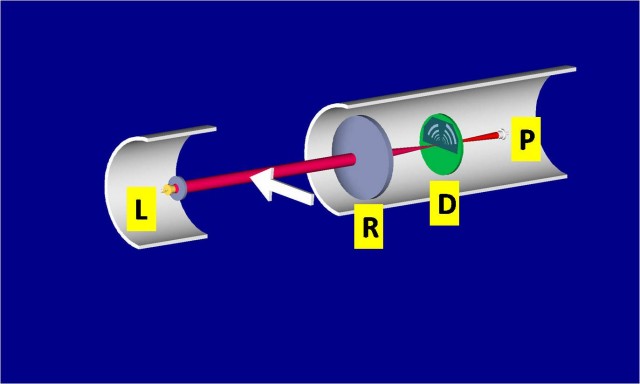This is a simple description. For detailed explanations see articles: Laser Diffraction-101 and -201.
Particle Size Distribution (PSD) is a multi-parameter description of how the total concentration of particles is distributed into many size fractions. For example, a 32-element PSD means that the total concentration is divided into 32 size fractions.
In order to get 32 pieces of information, one needs 32 independent measurements. In the laser diffraction method, these measurements are of light scattering into 32 angles. The figure below shows how that is done.

A laser (L) is collimated. Particles in water (at arrow) scatter light. A receiving lens (R) collects the scattered light. Behind the lens, at its focal plane is placed a special detector array (D). This array consists of 32 rings of silicon. Each ring detects scattering into a very specific small range of angles. These are the primary measurements constituting the data. Behind the ring detector is placed a photodiode (P). A hole in the center of the ring detector (D) allows the tightly focused laser beam to pass through. The photodiode P senses the power in this beam. A reduction in this power due to particles constitutes a measure of attenuation. This attenuation is used only to de-attenuate the light on rings. Following this de-attenuation, and after then subtracting a background (i.e. light on rings with filtered water), an inversion procedure produces the 32-element PSD.
Note that our new LISST-200X has 36 detectors and 36 size classes spanning a wider size range of particles; the original LISST-100X had 32. Our LISST-Portable |XR has 44 size classes that reach down to about 0.3 micron at the low end of sizes.
Common Misperceptions
Two misperceptions are common:
- The light on a ring does not correspond to the concentration in a size bin. This is because particles of any size put light on all rings, not just one; and
- The optical transmission (attenuation) is not used to interpret size distribution, nor concentration. It is only used to compensate for attenuation of scattered light. Even so, the transmission is offered as a measurement, because it is useful for comparison with the classic transmissometers/turbidity sensors, and it is an excellent measurement of a parameter of interested to optical oceanograhpers, namely. beam-attenuation coefficient, c.
For more advanced explanations, we have posted 2 articles. Start here.
Posted 02 April 2017